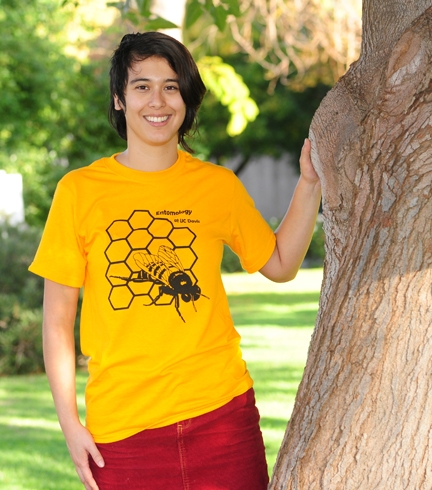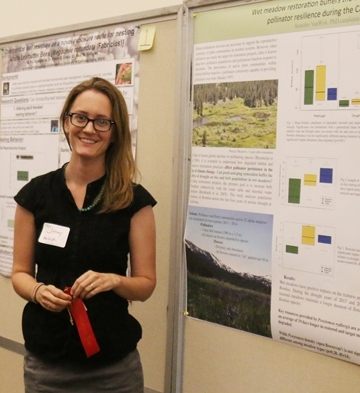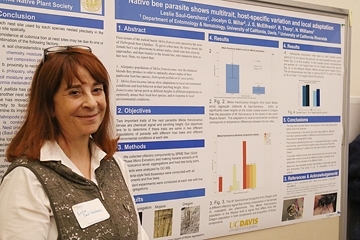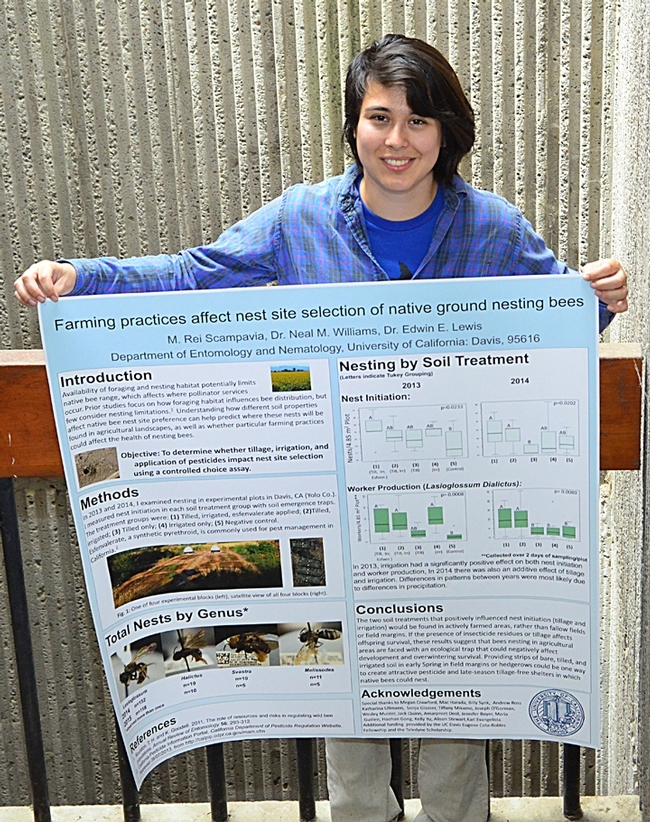
Margaret “Rei” Scampavia, a doctoral candidate who studies with major professors Neal Williams and Edwin Lewis of the Department of Entomology and Nematology, won first place for her research poster at the recent UC Davis Bee Symposium, held in the Robert Mondavi Center for Wine and Food Science.
Scampavia's poster, “Farming Practices Affect Nest Site Selection of Native Ground Nesting Bees,” won her the $1500 grand prize. The Henry J. Kaiser Family Foundation generously provided the funding.
Two other graduate students in the Neal Williams' lab won second and third place. Jennifer Van Wyk placed second for her poster on “Wet Meadow Restoration Buffers the Impact of Climate Change: Pollinator Resilience During the California Drought” and Leslie Saul-Gershenz, who also studies with professor Steve Nadler, placed third for her poster on “Native Bee Parasite Shows Multitrait, Host Specific Variation and Local Adaptation.” Van Wyk received a $1000 prize and Saul Gershenz, $500.
“Availability of foraging and nesting habitat potentially limits native bee range, which affects where pollinator services occur,” Scampavia wrote in her introduction. “Prior studies focus on how foraging habitat influences bee distribution, but few consider nesting limitations. Understanding how different soil properties affect native bee nest site preference can help predict where these nests will be found in agricultural landscapes, as well as whether particular farming practices could affect the health of nesting bees.”
Her objective: “to determine whether tillage, irrigation and application of pesticides impact nest site selection using a controlled choice assay.”

She examined the nests of bees in four genus categories: Lasioglossum, Halictus, Svastra and Melissodes.
Scampavia concluded “The two soil treatments that positively influenced nest initiation (tillage and irrigation) would be found in actively farmed areas, rather than fallow fields or field margins. If the presence of insecticide residues or tillage affects offspring survival, these results suggest that bees nesting in agricultural areas are faced with an ecological trap that could negatively affect development and overwintering survival. Providing strips of bare, tilled and irrigated soil in early spring in field margins or hedgerows could be one way to create attractive pesticide and late-season tillage-free shelters in which native bees could nest.”
Prior to coming to UC Davis, Scampavia worked for the U.S. Forest service as a biological technician, studying pollinator visitation to rare plants of the Mojave Desert. She also volunteered at Scripps College (Jupiter, Fla.) as a planner and coordinator for large education outreach events.

In addition to her PhD research, she participates in a variety of education outreach and conservation projects. She has presented lectures for the U.S. Fish and Wildlife Service as part of the Schoolyard Habitat Project; worked for the California Native Plant Society, documenting bee diversity in a threatened portion of Knowland Park in Oakland; and co-taught an undergraduate course focusing on current threats to pollinator populations and how to educate the general public to effect positive change.
Scampavia writes a bee blog, “Diadasia, The Lives of Other Bees,” at https://diadasia.wordpress.com/ that she launched in February 2012.
The Bee Symposium, sponsored by the Honey and Pollination Center and the UC Davis Department of Entomology and Nematology, featured keynote speaker Marla Spivak, Distinguished McKnight Professor, University of Minnesota and a 2010 MacArthur Fellow, who discussed "Helping Bees Stand on Their Own Six Feet." The symposium drew 360 people.
Entomology doctoral candidate Matthew Prebus of the Phil Ward lab, UC Davis Department of Entomology and Nematology, video-recorded the presentations and uploaded them today.
They are all on YouTube.
Marla Spivak: Protecting Pollinators
Amy Toth: Combined Effects of Viruses and Nutritional Stress on Honey Bee Health
Elina Niño: Best Management Practices to Support Honey Bee Health
Neal Williams: Enhancing Forage for Bees
Jake Reisdorf: Getting into Beekeeping- Thoughts from a 12-year-old Beekeeper
Katharina Ullmann: Project Integrated Crop Pollination
John Miller: Keeping Bees Healthy with Forage
Benjamin Sallman: Bee Informed Partnership
Gretchen LeBuhn: The Giant Sunflower Project
Christine Casey: Introduction to the Häagen Dazs Honey Bee Haven
Attached Images:
